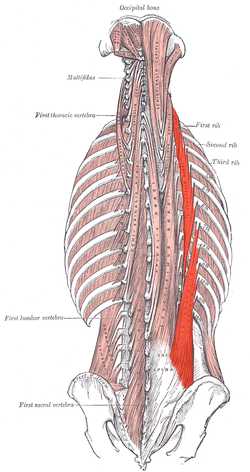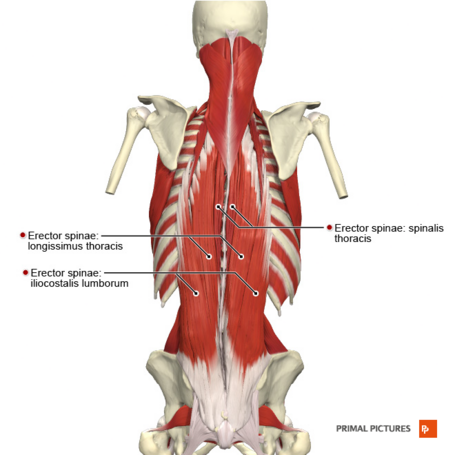Iliocostalis Lumborum: Difference between revisions
Abbey Wright (talk | contribs) No edit summary |
Abbey Wright (talk | contribs) No edit summary |
||
| Line 22: | Line 22: | ||
=== Origin === | === Origin === | ||
* Anterior surface of a broad and thick tendon | * Anterior surface of a broad and thick tendon attached to the medial crest of the [[sacrum]], | ||
* Spinous processes of the [[Lumbar Vertebrae|lumbar vertebrae]], | * Spinous processes of the [[Lumbar Vertebrae|lumbar vertebrae]], | ||
| Line 32: | Line 32: | ||
=== Insertion === | === Insertion === | ||
By tendons into inferior borders of the angles of the lower 6 or 7 [[ribs]]<ref name=":0" /> | By tendons into inferior borders of the angles of the lower 6 or 7 [[ribs]] <ref name=":0" /> | ||
=== Nerve Supply === | === Nerve Supply === | ||
Dorsal rami of thoracic and lumbar spinal [[Neurone|nerves]] (T7 to L3)<ref name="p3"> | Dorsal rami of thoracic and lumbar spinal [[Neurone|nerves]] (T7 to L3)<ref name="p3">Iliocostalis muscle [Internet]. Kenhub. 2021 [cited 1 December 2021]. Available from: https://www.kenhub.com/en/library/anatomy/iliocostalis-muscle</ref> | ||
=== Blood Supply === | === Blood Supply === | ||
| Line 43: | Line 43: | ||
=== Muscle Fibre === | === Muscle Fibre === | ||
Characterised by [[Muscle Fibre Types|Type 1 muscle fibre]], indicating the tonic holding and stabilisation function.<ref name=":1" /> | Characterised by [[Muscle Fibre Types|Type 1 muscle fibre]], indicating the tonic holding and stabilisation function.<ref name=":1" />[[File:Muscles of the back erector spinae group Primal.png|alt=|455x455px|thumb|Muscles of the back erector spinae group]] | ||
== Action == | == Action == | ||
*Extension of Spine: Acting bilaterally, extension and hyperextension of the spine. | *Extension of Spine: Acting bilaterally, extension and hyperextension of the spine. | ||
*Laterally flexes the spine when acting unilaterally<ref name="p2">Wheeless Textbook of Orthopaedics; Iliocostalis Lumborum | |||
http://www.wheelessonline.com/ortho/iliocostalis_lumborum_1 (accessed on 2.07.18)</ref> | http://www.wheelessonline.com/ortho/iliocostalis_lumborum_1 (accessed on 2.07.18)</ref> | ||
*[[Muscles of Respiration|Respiration]]: It assists as an accessory muscle of expiration, due to its insertion on the ribs<ref>Muscles Testing and Function;4th Edition; Kendall, McCreary, Provance; Accessory Muscles of Respiration, Page No.330.</ref> | *[[Muscles of Respiration|Respiration]]: It assists as an accessory muscle of expiration, due to its insertion on the ribs<ref>Muscles Testing and Function;4th Edition; Kendall, McCreary, Provance; Accessory Muscles of Respiration, Page No.330.</ref> | ||
*Stabilization of Spine: Iliocostalis lumborum along with [[Lumbar Multifidus|multifidus]] contribute to support and control the orientation of [[Lumbar Anatomy|lumbar spine]].<ref name=":1">Therapeutic Exercise for Spine Segmental Stabilization in Low Back Pain; Richardson, Jull, Hodges, Hides; Scientific Basis; Page No.24.</ref> | *Stabilization of Spine: Iliocostalis lumborum along with [[Lumbar Multifidus|multifidus]] contribute to support and control the orientation of [[Lumbar Anatomy|lumbar spine]].<ref name=":1">Therapeutic Exercise for Spine Segmental Stabilization in Low Back Pain; Richardson, Jull, Hodges, Hides; Scientific Basis; Page No.24.</ref> | ||
== Clinical Relevance: == | == Clinical Relevance: == | ||
= | * [[Low Back Pain|Lower back pain]] | ||
'''Power''' | * [[Myofascial Pain|Myofascial pain]]<ref name=":2">Roldan CJ, Huh BK. [https://pubmed.ncbi.nlm.nih.gov/27454266/ Iliocostalis thoracis-lumborum myofascial pain: Reviewing a subgroup of a prospective, randomized, blinded trial. A challenging diagnosis with clinical implications.] Pain physician. 2016 Aug 1;19(6):363-72.</ref> | ||
* [[Referred Pain|Referred pain]] can occur to the chest, abdomen or pelvis <ref name=":2" /> | |||
== Assessment == | |||
'''Power'''<ref name=":0" /> | |||
* Position: Prone with hands clasped behind buttocks or head. | * Position: Prone with hands clasped behind buttocks or head. | ||
Revision as of 14:18, 1 December 2021
Original Editor - Oyemi Sillo
Lead Editors - Vidya Acharya, Oyemi Sillo, Kim Jackson, Abbey Wright, Lucinda hampton, Evan Thomas, WikiSysop and 127.0.0.1
Description[edit | edit source]
Iliocostalis is a dorsal muscle situated deep to the fleshy section of serratus anterior. Iliocostalis lumborum is the lower (lumbar) portion of that muscle.
Iliocostalis lumborum is part of the erector spinae muscle group which includes iliocostalis, longissimus, and spinalis. The muscle bulk formed by this muscle group can be felt running parallel to the spine over the transverse processes of each vertebra. These muscles are vital for allowing free movement of the spine.
Injury to iliocostalis lumborum may be indicated by pain concentrated in the lower back or pain in the buttocks. Common daily activities may cause injury to the muscle including lifting a heavy object, rotating while lifting, or even sitting immobile for extended periods of time.
If there is a significant discrepancy between the strength of the abdominal muscles and the lumbar muscles of the back, it may result in a condition known as lumbar hyperlordosis. This condition can be successfully reversed through targeted stretches and exercises aimed at strengthening the deficient muscles.[1]
Anatomy[edit | edit source]
Origin[edit | edit source]
- Anterior surface of a broad and thick tendon attached to the medial crest of the sacrum,
- Spinous processes of the lumbar vertebrae,
- 11th and 12th thoracic vertebrae,
- Posterior part of the medial lip of iliac crest, supra-spinous ligament and the lateral crest of sacrum[2].
Insertion[edit | edit source]
By tendons into inferior borders of the angles of the lower 6 or 7 ribs [2]
Nerve Supply[edit | edit source]
Dorsal rami of thoracic and lumbar spinal nerves (T7 to L3)[3]
Blood Supply[edit | edit source]
Dorsal branches of the lumbar arteries from the aorta. Dorsal branches of the lateral sacral artery from the internal iliac artery.[3]
Muscle Fibre[edit | edit source]
Characterised by Type 1 muscle fibre, indicating the tonic holding and stabilisation function.[4]
Action[edit | edit source]
- Extension of Spine: Acting bilaterally, extension and hyperextension of the spine.
- Laterally flexes the spine when acting unilaterally[5]
- Respiration: It assists as an accessory muscle of expiration, due to its insertion on the ribs[6]
- Stabilization of Spine: Iliocostalis lumborum along with multifidus contribute to support and control the orientation of lumbar spine.[4]
Clinical Relevance:[edit | edit source]
- Lower back pain
- Myofascial pain[7]
- Referred pain can occur to the chest, abdomen or pelvis [7]
Assessment[edit | edit source]
Power[2]
- Position: Prone with hands clasped behind buttocks or head.
- Fixation: Examiner must stabilize the legs firmly on the table.
- Test: Trunk extension
Pressure: If performed with hands behind back no pressure is needed.
Weakness
- Bilateral weakness of low back muscles results in a lumbar kyphosis and increased thoracic kyphosis.
- Unilateral weakness results in lateral curvature with convexity towards the weak side.
Length
- Bilateral contracture of low back muscles results in lordosis.
- Unilateral contracture results in scoliosis with convexity to the opposite side.
Treatment[edit | edit source]
Strengthening exercises:[edit | edit source]
1. Prone extension exercise[8]:
a) In prone lying, have the patient tuck in the chin and lift the head, thorax of the plinth.
b) To progress further, the patient can vary the arm position. Resistance can be added by using hand-held weights.
c) Patient can further progress by lifting one leg off the mat alternately, and progress to both legs simultaneously.
d) Further progression can be made - spine extension with both upper limbs and lower limbs lifted off the mat.
2. Prone exercises on a stability ball.
3. Plank and quadruped exercises to develop control and strength in spinal extensors.
4.Postural exercises.
Stretching exercises:[edit | edit source]
Trunk lateral bending exercises to the opposite side of tightness and flexion exercises help in stretching the tight muscles.
References[edit | edit source]
- ↑ rehab my patients Iliocostalis Lumborum Available: https://www.rehabmypatient.com/lumbar-spine/iliocostalis-lumborum (accessed 1.12.2021)
- ↑ 2.0 2.1 2.2 Muscle Testing and Function;4th Edition; Kendall, McCreary, Provance; Page No.138.
- ↑ 3.0 3.1 Iliocostalis muscle [Internet]. Kenhub. 2021 [cited 1 December 2021]. Available from: https://www.kenhub.com/en/library/anatomy/iliocostalis-muscle
- ↑ 4.0 4.1 Therapeutic Exercise for Spine Segmental Stabilization in Low Back Pain; Richardson, Jull, Hodges, Hides; Scientific Basis; Page No.24.
- ↑ Wheeless Textbook of Orthopaedics; Iliocostalis Lumborum http://www.wheelessonline.com/ortho/iliocostalis_lumborum_1 (accessed on 2.07.18)
- ↑ Muscles Testing and Function;4th Edition; Kendall, McCreary, Provance; Accessory Muscles of Respiration, Page No.330.
- ↑ 7.0 7.1 Roldan CJ, Huh BK. Iliocostalis thoracis-lumborum myofascial pain: Reviewing a subgroup of a prospective, randomized, blinded trial. A challenging diagnosis with clinical implications. Pain physician. 2016 Aug 1;19(6):363-72.
- ↑ Therapeutic Exercise; Third Edition; Kisner & Colby; The Spine: Subacute, Chronic, and Postural Problems; Page No.562








